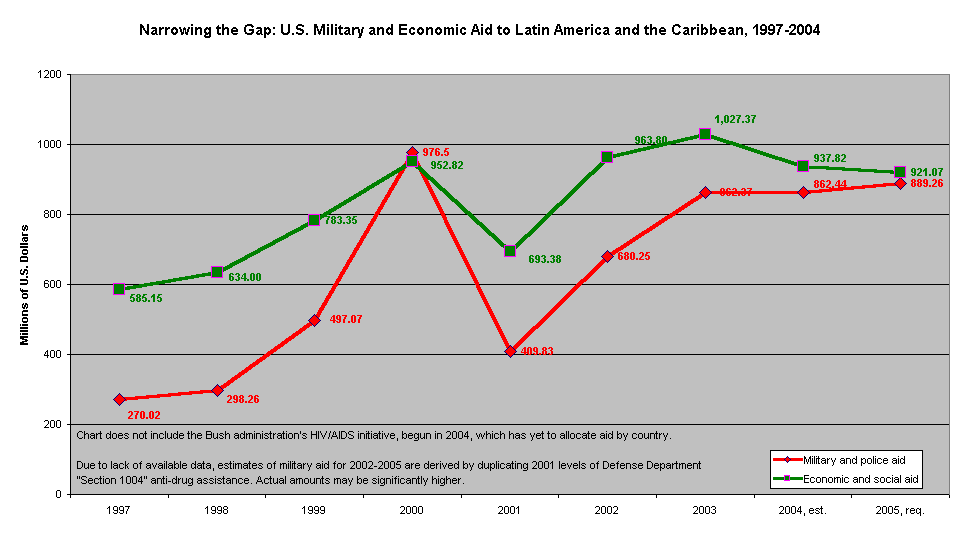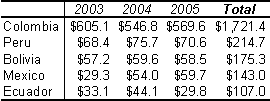Memorandum:
Highlights of the Bush Administration's 2005 Latin America aid request
February 19, 2004
For
easier printing, use Adobe Acrobat (PDF) version
MEMORANDUM
February
19, 2004
From:
Adam Isacson and Eric Stoner, Center for International Policy
Re:
Highlights of the Bush Administration’s 2005 Latin America aid
request
For
the most part, the Bush administration does not appear to be planning
any major departures from current assistance to Latin America and
the Caribbean. A few items in the aid proposal stand out sharply,
however:
-
Economic
aid is set to decline in both 2004 and 2005. Funding for development
and humanitarian-assistance programs to Latin America is expected
to decline by ten percent from 2003 to 2005. The aid request envisions
a sharp drop in funding for Child Survival and Health programs,
from $163.3 million to $130.3 million; and in Development Assistance,
from $260.6 million to $241.7 million.
In all, we estimate an economic-aid package of $1.027 billion
in 2003, $938 million in 2004, and $921 million in 2005.
By contrast, military aid is slowly increasing – it is now
nearly equal to total economic aid. Including defense-budget
counter-drug aid, which does not appear in the State Department
request, military and police aid to the hemisphere will grow from
an estimated $862 million in 2003 and 2004 to $889 million in
2005. Colombia leads the region in both economic-social and military-police
assistance (see chart and tables at the end
of this memo).
-
Though
only Colombia and Peru have groups on the State Department’s list
of foreign terrorist organizations, the word “terrorism” appears
frequently in the aid request’s description of U.S. programs
in each country:
-
“Argentina
understands the importance of cooperation against terrorism.
U.S. Antiterrorist Assistance programs brought Argentine officials
to the United States for valuable counter-terrorism briefings
and training.”
-
“Principal
U.S. interests in The Bahamas include: combating…financial
support for terrorism.”
-
“In
order to ensure that Bolivia does not become an active
transit point for international terrorism, we have also stepped
up cooperation with the Bolivian military, customs, immigration,
financial institutions, police and other organizations to
ensure better Bolivian control over its long, sparsely inhabited
borders.”
-
“The
government of Brazil, along with those of Argentina,
Paraguay, and the United States, has formed a working
group to combat the threat of terrorism in the tri-border
area.”
-
“Recognizing
the increasingly intertwined nature of narcotics trafficking
and terrorism, the Congress approved expanded authorities
to allow United States support for Colombia’s unified
campaign against both of these scourges.”
-
“FMF
[Foreign Military Financing] will train Dominican forces
capable of responding to terrorist threats.”
-
“The
principal U.S. interests in the seven countries of the Eastern
Caribbean…are preventing and combating transnational criminal
activity against the United States, including terrorism.”
-
Foreign aid will help the government of Ecuador with
the “disruption and interdiction of narcotics trafficking
and terrorism.”
-
International Military Education and Training (IMET) funding
will enhance the Honduran military’s “capabilities
in the war on terrorism.”
-
FMF funds in Nicaragua will provide equipment that
will “improve the Army’s capability to conduct counternarcotics,
counterterrorism, disaster relief, and search-and-rescue missions.”
-
FMF in Panama will “augment the GOP’s counter-terrorism,
security programs and maritime interdiction.”
-
“The
primary U.S. national interests in Paraguay are the
consolidation and strengthening of democracy and fortifying
the open market system, along with anti-corruption and counter-terrorism
efforts.”
-
Programs in Peru “will lower the risk of instability
in areas facing the quadruple threat of increased coca cultivation,
narco-trafficking, terrorism and minimal central government
presence. Challenges to this effort will be the budding alliance
between the narco-traffickers and the Shining Path.”
-
One of the “principal U.S. interests in Suriname” is
“stemming the flow of illegal drugs and migrants to the United
States, transnational crime, and international terrorism”;
“Transfer of grant EDA [Excess Defense Articles]… will assist
the Surinamese military in developing and sustaining regional
inter-operability and a viable counter-drug capability, as
well as in combating terrorism.”
-
IMET funding will “send Trinidad and Tobago Defense
Force personnel to U.S. military training courses to support
counterterrorism.”
-
“None
of Venezuela’s challenges -strengthening democracy,
fostering economic development, combating narcotics trafficking,
or fighting terrorism-can be addressed in isolation.” The
United States will use its “diplomatic resources… to press
for Venezuelan action against narcoterrorism.”
-
In
addition to continued support for herbicide fumigation and other
drug-war programs in Colombia, the request lists non-drug
military aid:
-
We
will provide operational support (training, supplies, repair
parts maintenance and infrastructure) and specialized equipment,
including weapons, night vision goggles and communications,
to the Army. The focus of this support will be on the elite
mobile brigades, the Rapid Reaction brigade (known by the
Spanish acronym FUDRA) and the Commando and Lancero Battalions.
-
The 5th and 18th Colombian Army Brigades, trained in 2003
to provide protection to the Cano Limon-Covenas pipeline,
a key element of Colombia’s economic infrastructure, will
receive additional munitions, equipment and training.
-
Support will also include establishing a national training
center and developing an automated logistical system.
-
FMF funding will also support the Colombian Navy and Air Force
and include the provision of interdiction boats, additional
combat aircraft, training and infrastructure improvements,
maintenance and operational support for Colombia’s C-130 transportation
fleet.
-
Our request includes funds to purchase battlefield medical
treatment, CSAR [combat search and rescue] and medevac-related
equipment and training for Army and Air Force units.
-
FMF also supports naval interdiction programs by providing
secure communications equipment, spare parts, and assistance
to establish an operations center.
-
Riverine forces will benefit from spare parts and other logistic
support.
-
The AKI [Anti-Kidnapping Initiative] provides tactical and
investigative training and equipment to the Colombian Government's
military and police anti-kidnapping units (Unified Action
Groups for Personal Liberty -Spanish acronym “GAULA”.) It
is also assisting in the establishment of an interagency anti-kidnapping
Joint Task Force, developing an interagency database to collect,
analyze and disseminate information on kidnappings and assist
in upgrading Colombian facilities. Three GAULA units have
completed training.
-
Though
it is commonly believed that Guatemala’s military receives
no U.S. aid, the request makes clear that International Narcotics
Control and Law Enforcement (INCLE) funds for Guatemala will provide
“training and equipment for … specific military units that are
responsible for interdiction and eradication.”
-
There
is some mention of U.S. aid for the creation of new military
and police units:
-
“The
[Bolivia] request also includes equipment and training
for the Bolivian Army’s new Counter-Terrorism Unit.”
-
Support for Colombia will “include establishing a national
training center and developing an automated logistical system.”
-
The Honduran Government is creating a “new combined
military-police unit that should benefit from EDA boats, vehicles,
and helicopters.”
-
In Peru, Andean Counter-Drug Initiative funds for 2005
will “support the planned Anti-Narcotics Coordination Center,
a non-lethal refinement of the past Airbridge Denial Program.”
The Airbridge Denial program, which seeks to detect and force
down aircraft suspected of trafficking drugs, has been suspended
in Peru since April 2001, when the Peruvian air force accidentally
downed a planeload of U.S. missionaries.
-
Throughout
the hemisphere, the aid request sees imminent narcotics threats,
naming nearly every country as an ideal “transshipment” point
for illegal drugs bound for the United States:
-
“The
tri-border area and Argentina’s northern border with
Bolivia are transshipment routes for illegal drugs
bound for the United States.”
-
“Only
50 miles from the United States at its closest point, the
Bahamian archipelago is a major transshipment point
for illegal narcotics and migrants bound for the United States.”
-
“Because
of its proximity to the United States and its position linking
Central America and Caribbean states, Belize is an
ideal transit point for illicit drugs headed for the United
States.”
-
While Chile is not a “center for the production or
transportation of illegal drugs…the picture may be evolving
as producers look to Chile as a source of precursor chemicals
and as a country through which to ship drugs en route to Europe
and the United States.”
-
Ecuador
has a “strategic position for the transshipment of narcotics,
precursor chemicals, and arms.”
-
“El
Salvador is a transit point for illegal immigration and
drugs to the United States.”
-
“Guatemala’s
strategic location makes it a significant transit point for
narcotics flows destined for the United States.”
-
“Guyana
is increasingly a transit point for narcotics destined for
the United States and Europe.”
-
“Jamaica
is a major Caribbean transit point for South American cocaine
en route to the United States.”
-
“Mexico
remains the major transit country for cocaine entering
the United States.”
-
“Paraguay
is a transshipment point for an estimated 40-60 metric tons
of cocaine per year, some of which reaches the United States.”
-
Suriname
is “a favorite transshipment country for weapons traffickers
and alien smugglers,” as well as drugs.
-
“Trinidad
and Tobago’s proximity to South America makes it a convenient
transshipment point for narcotics headed to the United States.”
-
“Venezuela
is a major transshipment route for illegal drugs destined
for the United States.”
-
According
to the request’s aid estimates, nearly every country that receives
non-drug military aid through FMF or IMET will either see no increase
or a drop in funding from 2004 to 2005. A handful of Central
American and Caribbean countries (Bahamas, Panama, Dominican
Republic, El Salvador, Honduras) will see some increase; the latter
three are among the few Latin American countries that have supported
the U.S. invasion and occupation of Iraq.

Military
and Police Assistance – top recipients
|
Economic
and Social Assistance – top recipients
|
|

|

|
|

